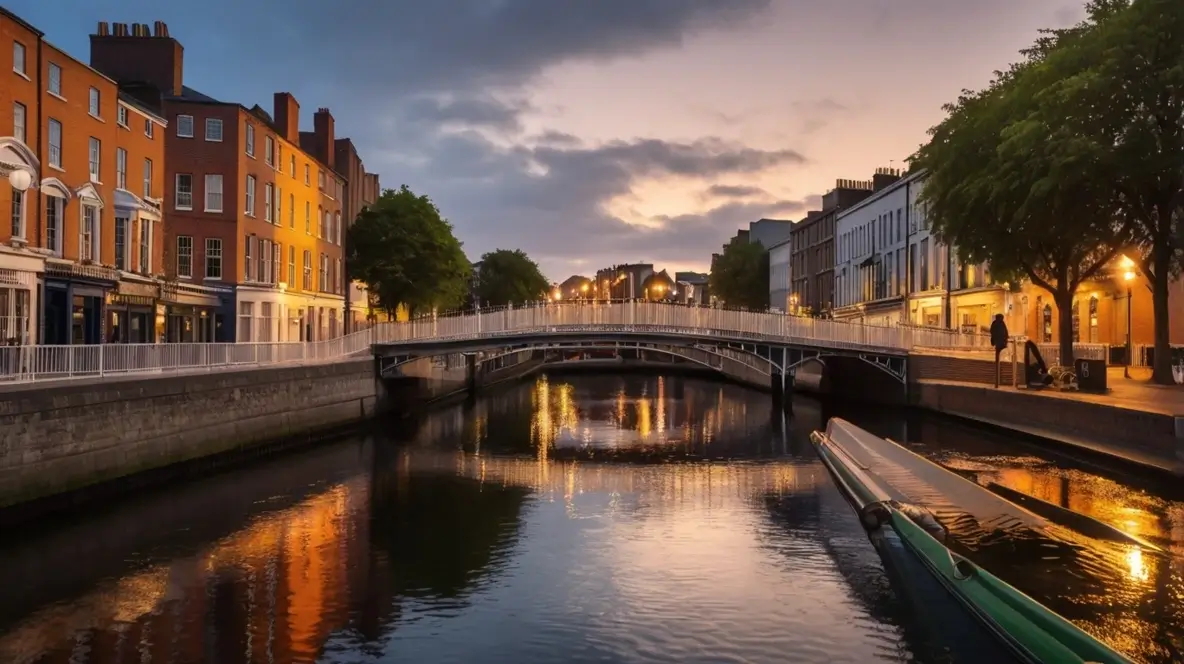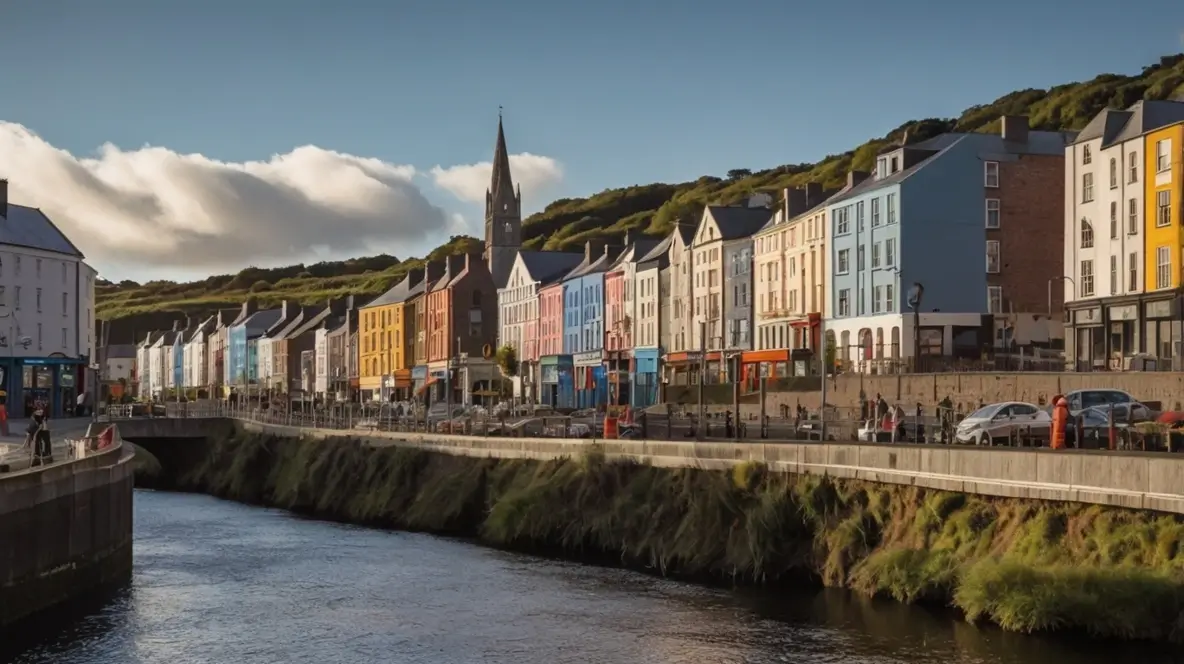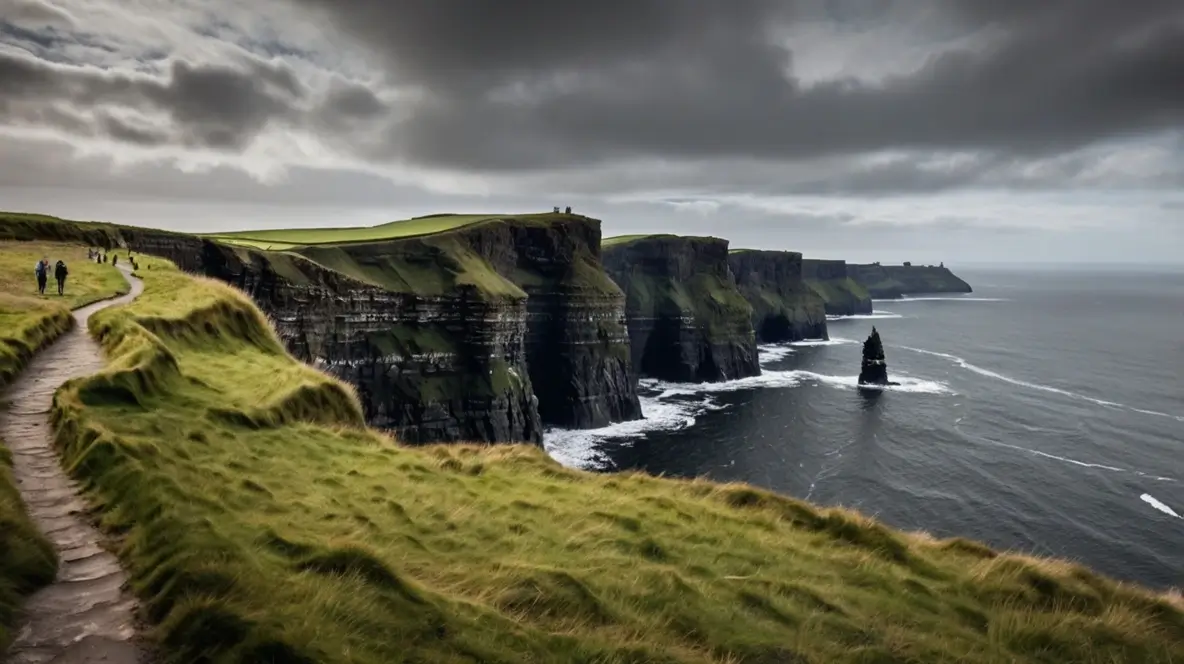Ireland captivates visitors with its lush landscapes, rich history, and warm hospitality.
A 4-day trip allows travelers to experience the country's highlights while immersing themselves in Irish culture.
From vibrant Dublin to the rugged Cliffs of Moher, Ireland offers diverse experiences that leave lasting impressions.
Exploring Ireland's compact size makes it possible to see multiple regions in a short time.
Visitors can wander through medieval castles, sample traditional Irish cuisine, and listen to live music in cozy pubs.
The country's natural beauty shines through in its rolling green hills, dramatic coastlines, and picturesque villages.
A well-planned 4-day itinerary balances urban exploration with rural charm.
Travelers can start in Dublin before venturing to other iconic destinations like Galway, the Ring of Kerry, or the Giant's Causeway.

How To Plan a 4 Day Ireland Trip?
A successful 4-day journey through Ireland requires careful preparation.
Key considerations include creating a focused itinerary, arranging travel and lodging, packing appropriately, and planning transportation within the country.
Itinerary Basics
A well-planned itinerary maximizes the Irish experience in a short timeframe.
Focus on 2-3 main regions or cities to avoid spending too much time in transit.
Popular choices include Dublin, Galway, and the Cliffs of Moher. Dublin offers rich history and culture, while Galway provides a charming coastal atmosphere. The Cliffs of Moher showcase Ireland's stunning natural beauty.
Consider dedicating one full day to each major location. This allows time for sightseeing, enjoying local cuisine, and soaking in the atmosphere. Leave some flexibility for spontaneous discoveries or unexpected delays.
Travel and Accommodation
Book flights and accommodations well in advance, especially during peak tourist seasons (June-August). Dublin Airport is the main international gateway, with good connections to other parts of the country. For lodging, choose a mix of hotels and B&Bs to experience Irish hospitality.
In Dublin, stay near the city center for easy access to attractions. In rural areas, farmhouse B&Bs offer a unique cultural experience.
Consider renting a car for flexibility, particularly when exploring countryside locations. Alternatively, trains and buses connect major cities and towns.
Weather and Packing Tips
Ireland's weather is notoriously changeable. Pack layers to adapt to varying conditions.
Essential items include:
-
Waterproof jacket
-
Comfortable walking shoes
-
Warm sweater or fleece
-
Umbrella
Bring adaptors for electrical devices, as Ireland uses three-prong plugs.
Don't forget a camera to capture the stunning landscapes and charming towns.
Check the forecast before departure, but be prepared for sudden changes. Even summer months can be cool and rainy.
Local Transportation Options
In cities like Dublin, public transportation is efficient and cost-effective. The Leap Card offers unlimited travel on buses, trams, and trains.
For exploring rural areas, consider these options:
-
Rental car: Provides flexibility but requires adjusting to driving on the left side.
-
Guided tours: Ideal for visiting remote locations without the stress of driving.
-
Train: Comfortable for longer journeys between major cities.
-
Bus: Economical option connecting towns and villages.
Cycling is popular in some regions, offering a unique way to experience the Irish countryside. Many towns have bike rental services available.
Day 1: Arrival and Dublin Exploration

Your first day in Ireland begins with exploring the vibrant capital city of Dublin.
This bustling metropolis offers a perfect blend of history, culture, and modern attractions.
Historical Landmarks
Dublin Castle stands as a testament to Ireland's rich history. Built in the 13th century, it now serves as a major government complex and tourist attraction on the wild atlantic way. Visitors can explore the State Apartments and medieval undercroft.
Trinity College, founded in 1592, boasts stunning architecture and houses the famous Book of Kells. This illuminated manuscript, a treasure of the wild atlantic, dates back to 800 AD and draws crowds eager to view its intricate designs.
St. Patrick's Cathedral, Ireland's largest church, impresses with its Gothic architecture. Founded in 1191 near Killarney National Park, it offers guided tours and hosts regular choir performances, making it a must-visit Ireland destination.
Culinary Scene
Dublin's food scene caters to all tastes and budgets.
Traditional Irish pubs serve hearty fare like Irish stew, boxty, and colcannon. The Brazen Head, Ireland's oldest pub, dates back to 1198 and offers live music with dinner.
For a modern twist, visit the trendy restaurants in the Temple Bar area.
Here, chefs reimagine Irish classics using locally sourced ingredients. Vegetarian and vegan options are also widely available.
Food markets like the Temple Bar Food Market showcase local produce and artisanal goods. Visitors can sample Irish cheeses, fresh oysters, and homemade bread.
Evening Entertainment
As night falls, Dublin comes alive with entertainment options.
The Guinness Storehouse offers evening tours, culminating in a pint at the Gravity Bar with panoramic city views.
Traditional Irish music sessions fill pubs across the city. O'Donoghue's Bar on Merrion Row is known for its lively atmosphere and talented musicians.
For theater enthusiasts, the Abbey Theatre presents classic and contemporary Irish plays. The Gate Theatre offers a mix of international and Irish productions in an intimate setting.
Day 2: The Charm of Cork

Cork offers a blend of history, culture, and natural beauty. Visitors can explore bustling markets, kiss a legendary stone, and step back in time at a former prison.
The English Market
The English Market stands as Cork's culinary heart, a vital stop on any west coast, Ireland itinerary. This covered market dates back to 1788 and brims with local produce, artisanal foods, and traditional Irish fare. As part of a broader driving trip, visitors can enjoy the rich offerings here before heading to both the Dingle Peninsula and Christ Church Cathedral.
Stalls display an array of fresh fish, locally sourced meats, and aromatic cheeses. Vendors offer specialty items like spiced beef, a Cork delicacy, perfect for those looking to savor the local flavors before they visit Dublin.
The market's architecture adds to its charm, featuring ornate Victorian fountains and vaulted ceilings. Visitors can sample local treats or enjoy a meal at the market's cafes, making it a memorable part of their journey through Ireland.
Blarney Castle
Blarney Castle, a medieval stronghold, sits just outside Cork city. Built over 600 years ago, it attracts tourists eager to kiss the famed Blarney Stone.
Legend claims this act bestows the gift of eloquence. Visitors climb narrow stairs to reach the stone, then lean backwards to kiss it while holding onto iron railings.
The castle grounds feature extensive gardens, including the Poison Garden with its collection of toxic plants. Rock Close, a prehistoric druidic settlement, adds mystique to the site.
Cork City Gaol
Cork City Gaol offers a glimpse into 19th-century prison life. This former jail now serves as a museum, showcasing the harsh conditions inmates once endured.
Life-like wax figures and sound effects create an immersive experience. Visitors can explore the cells, see the governors' quarters, and learn about famous prisoners.
The museum details the social history of Cork during the Irish famine and subsequent years. Audio guides provide in-depth information about the prison's history and its inmates' stories.
Day 3: The Cliffs of Moher and Galway City

The third day of the Irish adventure combines breathtaking natural wonders with vibrant urban culture. Visitors experience the majestic Cliffs of Moher before exploring the lively streets and traditional music scene of Galway City.
Coastal Views
The Cliffs of Moher stand as one of Ireland's most iconic landmarks.
Rising dramatically from the Atlantic Ocean, these sheer rock faces stretch for 14 kilometers along the western coast of County Clare.
Visitors can walk along well-maintained pathways to various viewing points, each offering stunning vistas of the rugged coastline.
O'Brien's Tower, perched atop the cliffs, provides a 360-degree panorama of the surrounding landscape. On clear days, the Aran Islands are visible in the distance.
The Cliffs of Moher Visitor Experience offers interactive exhibits about the local geology, flora, and fauna.
For the adventurous, boat tours departing from Doolin allow visitors to view the cliffs from sea level, providing a unique perspective on their towering height.
Galway's Vibrant Streets
Galway City pulses with energy and charm.
The Latin Quarter forms the heart of the city, with its narrow cobblestone streets lined with colorful shopfronts, boutiques, and cafes. Street performers entertain crowds with music and acrobatics.
Eyre Square, a central public park, offers a pleasant spot for relaxation. The 16th-century Spanish Arch and the Galway City Museum provide insights into the area's rich history.
Food lovers can explore the Galway Market, held year-round, featuring local produce, artisanal foods, and crafts.
The city's dining scene ranges from traditional Irish pubs to innovative contemporary restaurants, many showcasing fresh seafood from Galway Bay.
Traditional Irish Music
Galway's reputation as a hub for traditional Irish music is well-deserved.
The city boasts numerous pubs hosting nightly live music sessions. Tigh Neachtain and The Crane Bar are popular venues for authentic performances.
Visitors can often witness spontaneous gatherings of musicians playing traditional instruments like fiddles, bodhráns, and tin whistles.
These sessions, known as "trad sessions," welcome audience participation through singing or clapping along.
For those interested in learning more, the Galway Arts Centre offers workshops on Irish music and dance. The city also hosts several music festivals throughout the year, celebrating both traditional and contemporary Irish music.
Day 4: Northern Ireland and the Giant's Causeway
The final day takes you to Northern Ireland's stunning coastline, featuring dramatic cliffs, unique geological formations, and scenic landscapes. You'll explore iconic sites steeped in natural beauty and cultural significance.
The Antrim Coast
The Antrim Coast offers breathtaking views of rugged cliffs and the Irish Sea.
Drive along the winding coastal road, stopping at viewpoints to admire the scenery. Visit the Giant's Causeway, a UNESCO World Heritage site famous for its hexagonal basalt columns.
Legend attributes the causeway to the giant Finn MacCool, while science explains it as the result of ancient volcanic activity.
Walk along the 40,000 interlocking columns, marveling at this natural wonder.
The visitor center provides interactive exhibits about the area's geology and mythology.
Don't miss the Giant's Boot and Organ, unique rock formations shaped by millions of years of erosion.
Carrick-a-Rede Rope Bridge
For a thrilling experience, head to Carrick-a-Rede Rope Bridge. This 20-meter bridge spans a 30-meter chasm between the mainland and a small island.
Originally used by salmon fishermen, it now attracts adventurous tourists.
Cross the swaying bridge for panoramic views of the coastline and Rathlin Island. On clear days, you might even spot Scotland in the distance.
The surrounding cliffs are home to diverse seabirds, making it a popular spot for birdwatching.
Book your time slot in advance, as the bridge can get busy during peak season. Wear comfortable shoes and be prepared for a short coastal walk to reach the bridge.
The Dark Hedges
End your day with a visit to the Dark Hedges, an avenue of beech trees made famous by the TV series Game of Thrones. Planted in the 18th century, these gnarled trees form an atmospheric tunnel over the road.
The best time to visit is early morning or late afternoon when the light filtering through the branches creates a magical atmosphere.
Capture stunning photos of this unique landscape.
While the site can get crowded, patience will reward you with moments of tranquility. Take time to appreciate the trees' intricate shapes and the play of light and shadow.
Cultural Etiquette and Tips for 4 Days in Ireland
Ireland has unique social customs and etiquette that visitors should be aware of. Understanding these norms can enhance your experience and help you navigate interactions with locals more smoothly.
Social Norms
Irish people are known for their friendliness and warm hospitality. Greetings often involve a handshake and direct eye contact.
Personal space is valued, so avoid standing too close during conversations.
In pubs, it's customary to order and pay for drinks at the bar rather than waiting for table service. When joining a group, it's polite to offer a round of drinks.
Punctuality is appreciated but not strictly adhered to. Being 5-10 minutes late is generally acceptable for social gatherings.
Tipping Practices
Tipping in Ireland is less common than in some other countries, but it's still appreciated for good service. Here's a quick guide:
-
Restaurants: 10-15% for table service (if not already included)
-
Taxis: Round up the fare or add 10%
-
Bars: Not expected, but rounding up is common
-
Hotels: €1-2 per bag for porters, €1-2 per night for housekeeping
Tipping is not necessary for counter service or in pubs when ordering drinks at the bar.
Irish Phrases
Learning a few Irish phrases can help you connect with locals and show respect for the culture. Here are some useful expressions:
-
"Sláinte" (SLAWN-cha): Cheers, used for toasts
-
"Go raibh maith agat" (Guh rev mah a-gut): Thank you
-
"Dia duit" (JEE-uh gwitch): Hello
-
"Craic" (Crack): Fun or enjoyment, as in "What's the craic?"
Using these phrases in appropriate situations can bring smiles and appreciation from Irish people. Remember, English is widely spoken, but efforts to use Irish are often welcomed.
Local Cuisine and Dining
Ireland's food scene offers a delightful mix of traditional dishes and modern culinary innovations. Visitors can savor hearty meals, craft beverages, and locally-sourced ingredients that showcase the country's rich gastronomic heritage.
Traditional Dishes
Irish stew stands out as a beloved comfort food, featuring tender lamb, potatoes, and root vegetables. Boxty, a potato pancake, is a versatile dish enjoyed across the country.
Colcannon combines mashed potatoes with kale or cabbage, often served as a side dish. Seafood lovers can indulge in fresh fish and chips or Dublin Bay prawns.
For breakfast, the full Irish fry-up includes bacon, sausages, eggs, black and white pudding, and soda bread. Vegetarians can opt for coddle, a meatless version of the traditional Dublin dish.
Craft Beers and Whiskeys
Ireland's brewing tradition shines through its craft beer scene. Microbreweries like Galway Bay Brewery and Eight Degrees Brewing offer unique flavors and styles.
Irish whiskey has gained global recognition. Distilleries such as Jameson, Bushmills, and Teeling produce smooth, triple-distilled spirits. Many offer tours and tastings.
Craft distilleries like Dingle and Glendalough create small-batch whiskeys with distinctive local characteristics. Beer and whiskey pairings are popular in Irish pubs, allowing visitors to explore complementary flavors.
Local Cheese and Produce
Irish farmhouse cheeses have earned international acclaim. Cashel Blue, a creamy blue cheese from Tipperary, pairs well with local honey.
Gubbeen, produced in West Cork, offers a mild, nutty flavor. Coolea, a Gouda-style cheese from County Cork, ages beautifully.
Farmers' markets showcase seasonal produce. Look for Irish strawberries in summer and Brussels sprouts in winter. Locally-grown potatoes, carrots, and cabbage feature prominently in traditional dishes.
Artisanal producers create unique products like seaweed-infused butter and small-batch jams. These items make excellent souvenirs for food enthusiasts.
Outdoor Adventures for a 4-Day Ireland Itinerary
Ireland's stunning landscapes offer a wealth of opportunities for outdoor enthusiasts. From rugged coastlines to rolling hills, the Emerald Isle provides diverse terrain for activities like hiking, kayaking, and golfing.
Hiking and Walking Trails
Ireland boasts an extensive network of hiking trails suitable for all skill levels. The Wicklow Way, stretching 131 km through the Wicklow Mountains, offers breathtaking views of lakes, valleys, and forests. Hikers can explore ancient monastic sites and spot native wildlife along the route.
The Cliffs of Moher Coastal Walk in County Clare provides a dramatic 18 km trail along the Atlantic coast. Walkers can marvel at the 214-meter-high cliffs and enjoy panoramic ocean vistas.
For a shorter excursion, the 5 km Glendalough Spinc Trail in County Wicklow leads through a glacial valley, passing by medieval ruins and pristine lakes.
Water Sports
Ireland's coastline and numerous lakes make it an ideal destination for water sports enthusiasts. Surfing is popular along the western coast, with Bundoran in County Donegal and Lahinch in County Clare offering excellent waves for both beginners and experienced surfers.
Sea kayaking allows visitors to explore hidden coves and coastal caves. Guided tours are available in locations like Dingle Bay and the Skellig Islands.
Stand-up paddleboarding has gained popularity on Ireland's inland waterways. The calm waters of Lough Derg and Lough Corrib provide perfect conditions for this activity.
Golfing in Ireland
Ireland is renowned for its world-class golf courses, many of which offer stunning coastal views. The Old Course at Ballybunion in County Kerry is consistently ranked among the top courses globally, featuring challenging links-style play along the Atlantic.
Royal County Down in Northern Ireland boasts two 18-hole courses set against the backdrop of the Mourne Mountains. Its Championship Course is particularly famous for its natural beauty and demanding layout.
For a unique experience, golfers can visit the K Club in County Kildare, which hosted the 2006 Ryder Cup. The club features two championship courses designed by Arnold Palmer.
Departure and Reflection
The final day of the Ireland trip arrived swiftly. Travelers packed their bags, reflecting on the whirlwind adventure of the past four days.
Memories of rolling green hills, ancient castles, and lively pubs filled their minds.
Many visitors felt a mix of emotions as they prepared to leave. Excitement about returning home mingled with a tinge of sadness at saying goodbye to the Emerald Isle.
At the airport, last-minute souvenir shopping ensued. Popular items included:
-
Irish wool sweaters
-
Celtic jewelry
-
Local whiskey and craft beers
-
Traditional music CDs
Some travelers jotted down notes about their favorite experiences. Others scrolled through photos on their phones, reliving special moments.
The journey home provided time for contemplation. Visitors considered how to incorporate elements of Irish culture into their daily lives back home.
Some planned to try new recipes or listen to more traditional music.
Many resolved to return to Ireland in the future. They recognized four days only scratched the surface of what the country had to offer. The friendly locals, rich history, and stunning landscapes left a lasting impression on all who experienced them.
Frequently Asked Questions
1. What is the best itinerary for a 4-day trip to Ireland?
A balanced 4-day itinerary includes two days in Dublin and two days exploring the countryside.
Start with Dublin's city center, visiting Trinity College and the Guinness Storehouse.
On day two, take a day trip to the Cliffs of Moher.
Spend day three exploring Kilkenny Castle and the Rock of Cashel.
Return to Dublin on day four for the National Museum and shopping on Grafton Street.
2. How can I explore Ireland in 4 days without renting a car?
Public transportation and guided tours offer excellent alternatives to renting a car.
Use Dublin's efficient bus and tram system to navigate the city.
For trips outside Dublin, book guided day tours or use Ireland's train network.
Many tour companies offer comprehensive packages that cover major attractions and provide transportation.
3. Which attractions should I prioritize on a 4-day visit to Ireland from Dublin?
Focus on a mix of urban and rural experiences. In Dublin, visit Trinity College, Dublin Castle, and the Guinness Storehouse.
Outside the city, prioritize the Cliffs of Moher, Blarney Castle, and the Ring of Kerry. These iconic sites offer a taste of Ireland's natural beauty and rich history.
4. Can you suggest family-friendly activities for a 4-day stay in Ireland with children?
Dublin Zoo provides a fun day out for families. The National Leprechaun Museum offers an entertaining dive into Irish folklore.
Outside Dublin, consider Bunratty Castle and Folk Park for interactive history lessons. The Cliffs of Moher Visitor Experience combines education with breathtaking views.
5. What are the must-see destinations in Dublin for a 4-day visit?
Trinity College and the Book of Kells are essential stops. The Guinness Storehouse offers insight into Ireland's brewing history.
Dublin Castle and St. Patrick's Cathedral showcase the city's historical significance. For a local experience, explore Temple Bar and take a stroll through St. Stephen's Green.
6. When is the ideal time of the year to plan a 4-day trip to Ireland?
Late spring (April to May) and early fall (September to October) offer mild weather and fewer crowds.
These months provide comfortable conditions for sightseeing and outdoor activities.
Summer (June to August) brings warmer temperatures but also more tourists.
Winter trips (November to March) can be chilly and wet but offer festive charm and lower prices.
